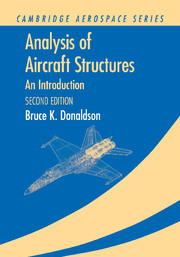Book contents
- Frontmatter
- Contents
- Introduction to the Second Edition
- Introduction to the First Edition
- List of Repeated Engineering Symbols
- Acknowledgments
- Part I The Fundamentals of Structural Analysis
- Part II **Introduction to the Theory of Elasticity**
- Part III Engineering Theory for Straight, Long Beams
- 9 Bending and Extensional Stresses in Beams
- 10 Beam Bending and Extensional Deflections
- 11 Additional Beam Bending Topics
- 12 Uniform Torsion of Beams
- 13 Beam Torsion Approximate Solutions
- Beam Bending and Torsion Review Questions
- 14 Beam Shearing Stresses Due to Shearing Forces
- Part IV Work and Energy Principles
- Part V Energy-Based Numerical Solutions
- Part VI Thin Plate Theory and Structural Stability
- Appendix A Additional Topics
- Appendix B Selected Answers to Exercises
- References
- Index
11 - Additional Beam Bending Topics
from Part III - Engineering Theory for Straight, Long Beams
Published online by Cambridge University Press: 05 June 2012
- Frontmatter
- Contents
- Introduction to the Second Edition
- Introduction to the First Edition
- List of Repeated Engineering Symbols
- Acknowledgments
- Part I The Fundamentals of Structural Analysis
- Part II **Introduction to the Theory of Elasticity**
- Part III Engineering Theory for Straight, Long Beams
- 9 Bending and Extensional Stresses in Beams
- 10 Beam Bending and Extensional Deflections
- 11 Additional Beam Bending Topics
- 12 Uniform Torsion of Beams
- 13 Beam Torsion Approximate Solutions
- Beam Bending and Torsion Review Questions
- 14 Beam Shearing Stresses Due to Shearing Forces
- Part IV Work and Energy Principles
- Part V Energy-Based Numerical Solutions
- Part VI Thin Plate Theory and Structural Stability
- Appendix A Additional Topics
- Appendix B Selected Answers to Exercises
- References
- Index
Summary
Introduction
This chapter introduces three topics that expand the usefulness of the Bernoulli–Euler beam bending and extension equations developed in the previous chapter. The first topic is elastic beam end supports. The use of elastic end supports begins the process, developed further in Part V, of modeling beams that are parts (elements) of larger elastic structures. The second topic is partial span distributed loads, and concentrated loads acting at points other than the beam ends. Then, both as another form of loading, and as a prelude to the third topic, combined lateral and axial loading cases are also examined. The third topic is beam buckling. This chapter provides only a brief introduction to beam buckling theory. However, some of the complexities of the topic are mentioned without being explored mathematically. The mathematical differences between the one standard type of buckling analysis introduced here and all the other beam analyses of this chapter and Chapter 10 are underscored. Additional aspects of beam and plate buckling theory are provided in Part VI.
Before proceeding to these three topics, it is worthwhile mentioning again a limitation on the scope of the beam bending theory developed in Chapter 10 which is retained in this chapter. That limitation is that the bending deflections are small. Thus it is possible to confine the axial and bending interactions to the bending equations, and to deal with the bending and twisting deflections separately, without regard for any interaction between them.
- Type
- Chapter
- Information
- Analysis of Aircraft StructuresAn Introduction, pp. 310 - 367Publisher: Cambridge University PressPrint publication year: 2008



